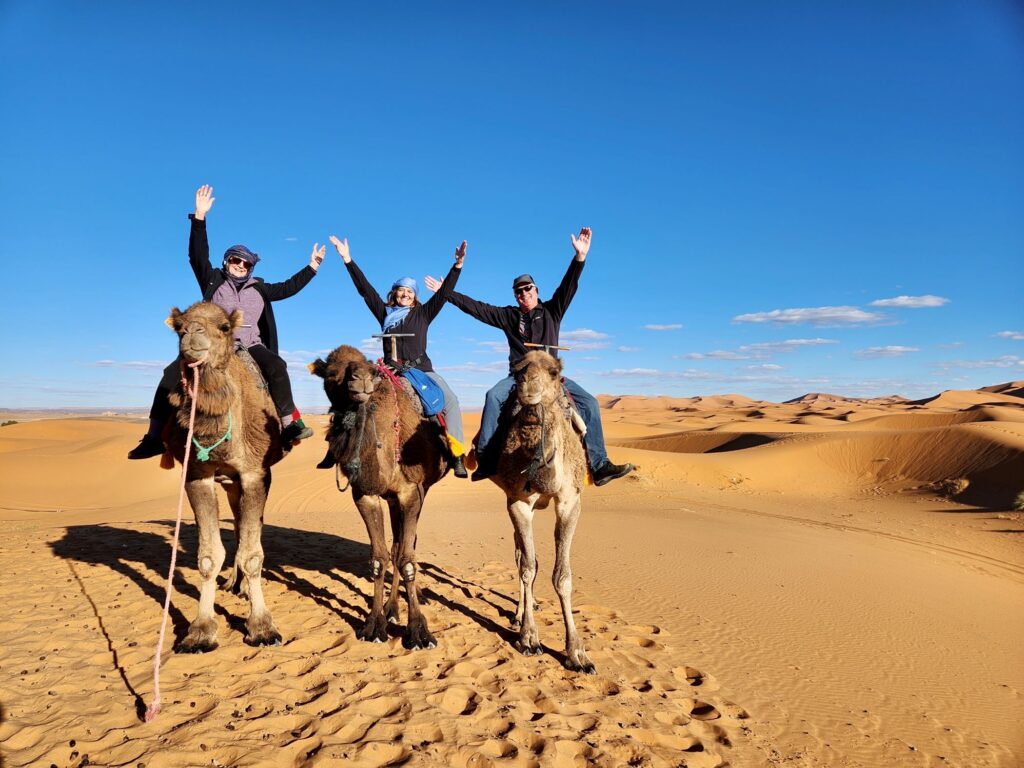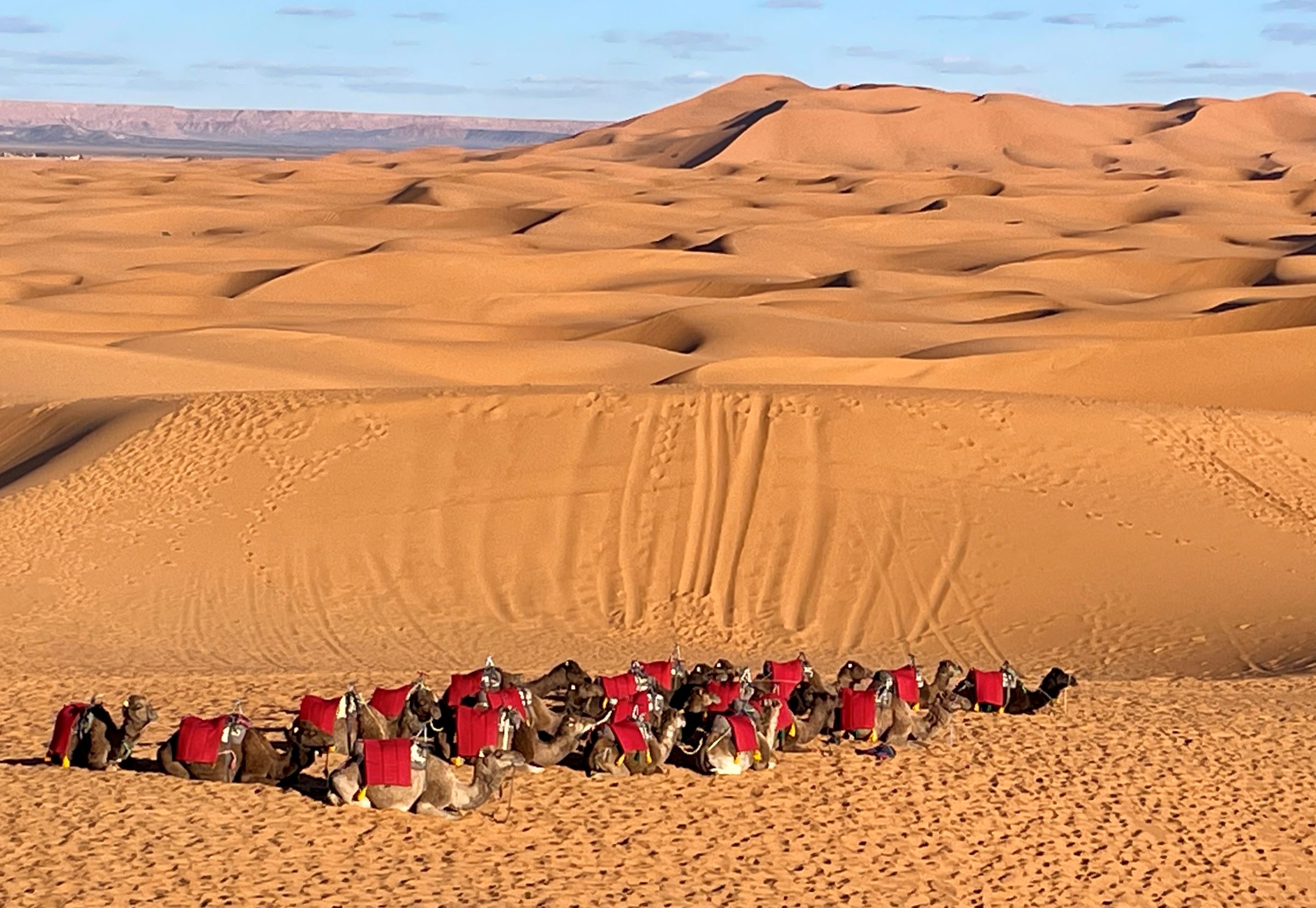A visit to the North African country of Morocco awakens the senses.
In Rabat, the savory aroma of chicken simmering with olives in a clay tajine pot piqued my sense of smell. The cobalt blue walls in Chefchouen’s maze-like medina nearly blinded me on a sunny day.
The lyrical sound of the “call to prayers” echoed in my ears from small-town minarets in the Atlas Mountains to the country’s largest Islamic mosque in Casablanca. I could not resist running my fingers over the hand-chiseled tiles of medieval fountains in Fez.
Everywhere I traveled, I sipped Morocco’s soothing national drink – tea flavored with sprigs of fragrant fresh mint and sweetened with honey.
Morocco: An Exotic Blend of Cultures
Morocco is an exotic mashup of history, cultures, cuisines and traditions. It is only a dozen miles from Spain, across the Strait of Gibraltar. The resulting colonial influences from Europe, combined with the rich history of the original Berber tribes and Arab settlers, have helped create a country that is one of the most fascinating and popular places to visit in the world.
This story originally appeared March 8, 2023 on Gate 1 Travel’s website, along with a second story detailing the stops on my 13-day Kaleidoscope Tour. I received a discount on my Gate 1 tour in return for writing about my experience. All opinions are mine. You can read my second Gate 1 story here.
I recently joined the legion of Morocco admirers after traveling through the country’s vast and beautiful landscape on a 13-day tour with Gate 1 Travel, which offers tours to countries around the world. My Kaleidoscope Tour is one of 10 different experiences available year-round in Morocco. Itineraries include international and domestic transportation as well as adventurous optional excursions and good-to-great lodging and food.
I traveled in a comfortable bus with 22 strangers who quickly became friends. Beginning in Rabat, the modern capital on the Atlantic Coast, we explored Roman ruins before winding through the snow-capped peaks of the Middle Atlas Mountains to the sand dunes of the Sahara Desert. After a trip highlight – a camel ride in the desert at sunset – we crossed back over the High Atlas Mountains farther south to join merrymakers in the old city square of Marrakesh. Our tour ended in Casablanca, Morocco’s dynamic largest city on the Atlantic.

![]() Diverse Geography Includes Mountains, Coastal Beaches
Diverse Geography Includes Mountains, Coastal Beaches
Along the way, we learned about the country’s fascinating past and its people from our excellent tour manager and guide, Amrabt Mohammed. An engaging storyteller, the Tangier native helped us understand the country’s culture and to appreciate its stunning geography. Local tour guides joined us in different cities to provide more in-depth insights.
The kingdom of Morocco hugs the northwestern corner of Africa, along the Mediterranean Sea and the Atlantic Ocean. Mountains separate coastal areas from the Sahara, where Berber tribes fought for power as Arabs swept in from Arabia in the 7th century. The Muslim empire spread widely to include the Iberian Peninsula to the north. But when the Spanish Inquisition began in the 15th century, many Muslims (also known as Moors) and Jews fled to Morocco, taking their Andalusian traditions from southern Spain with them.
Though Morocco was never officially a colony of a European power, parts of the country fell under the control of Spain and France during their empire building days. Morocco finally gained full independence from France in 1956.
King Invests in Future and Preserving Past
Current King Mohammed VI has accelerated modernization efforts in the country, which is about the size of California with a population of 37 million. At the same time, the government is also refurbishing ancient kasbahs (miliary forts), medinas (old walled cities), vibrant souks (markets), and adobe ksars (fortified towns) — many of which are UNESCO World Heritage sites.
With the new cities built by the French surrounding the old medinas, the result is an intoxicating mélange that has seduced curious visitors for decades – from painters like Matisse who loved its golden light to writers like Paul Bowles who captured its people in his prose and musicians like Bob Marley who sought haven in its counterculture.

The Moroccan people are proud of their diverse heritage. Many men still dress conservatively in traditional djellabas (loose fitting robes), while women wear hijabs (headscarves) and djellabas. Western wear is also common in cities. Though Islam is the national religion, others are tolerated. Moroccan Arabic is the official language, but French is frequently spoken, especially in cities. Many people in tourist areas also know some English.
Hospitality a Tradition in Morocco
Friendly and welcoming best describes the people I met in Morocco. A few aggressive touts were bothersome, but most shopkeepers greeted me cordially. Then, as is expected in the country, they haggled good-naturedly over the prices for handmade craft goods in the vibrant souks. Even if you are not a shopper, getting lost in the vibrant and chaotic souks is an essential experience. But beware, it is easy to get overwhelmed by the sheer volume of everything from plush Berber carpets to artful ceramics and handmade leather camels that are packed into tiny stalls in crowded aisles of the souks
The souks are wonderfully aromatic places to shop for spices such cumin, ginger, turmeric and cinnamon that flavor Moroccan food. The country’s cuisine is a delicious blend of traditional Berber dishes, accented with French, Middle Eastern and Andalusian flavors. Fresh locally grown vegetables and fruit complement main dishes of lamb, poultry and seafood. Couscous is popular as are casseroles, or stews, (called tajines in Morocco), cooked in earthen pots with conical lids, also known as tajines.
In Fez, a local family hosted my entire tour group for a homecooked meal of chicken tajine with lemons and olives, multiple vegetable dishes, fresh bread and, of course, unlimited mint tea. (Though tap water is considered safe, Gate1 provided us with bottled water.)

Tour Manager Shares Local Customs
Our tour manager Mohammed typified the best of Moroccan hospitality. Though some days on the bus were long, he entertained us with stories to help us understand the country. He pointed out that you can often tell where local women live by the color or style of their headscarves.
Mohammed also explained that date palm trees and their fruit are essential to life in the oases of the Sahara. In the afternoons, he shared Moroccan sweets such as my favorite — dates stuffed with almonds. No inane question went unanswered, and he did not complain too much when bathroom stops turned into shopping sprees.
When it was time to depart for the next destination, he herded us on to the bus with a smile and “Yallah, yallah.” (Let’s go, in Moroccan Arabic).
 As a journalist, I’ve written about crime for newspapers, business deals for magazines, cruise ship ports for online travel publications and industry trends for websites. My focus now is exclusively on travel.
As a journalist, I’ve written about crime for newspapers, business deals for magazines, cruise ship ports for online travel publications and industry trends for websites. My focus now is exclusively on travel. 


These tours are looking pretty good! Living the dream – or at least a piece of it – traveling and writing, with informed guides. I have a friend whose husband worked in Qatar quite a bit over recent decades. She also speaks in amazed tones about wandering the souks. I do wonder what would be an example of an inane question…We all probably have a few of those!